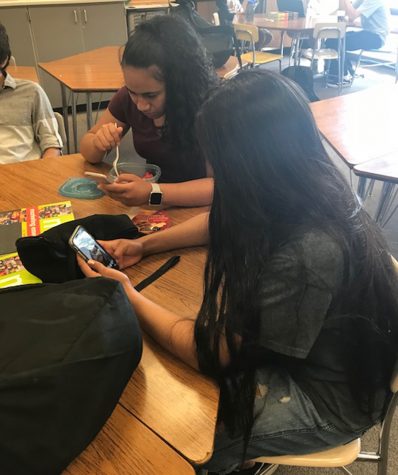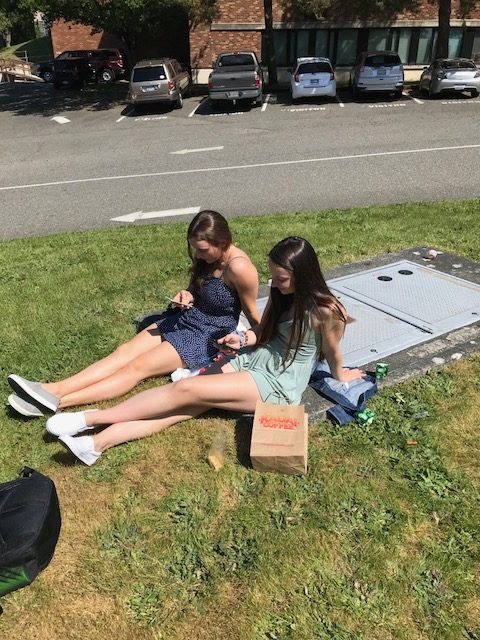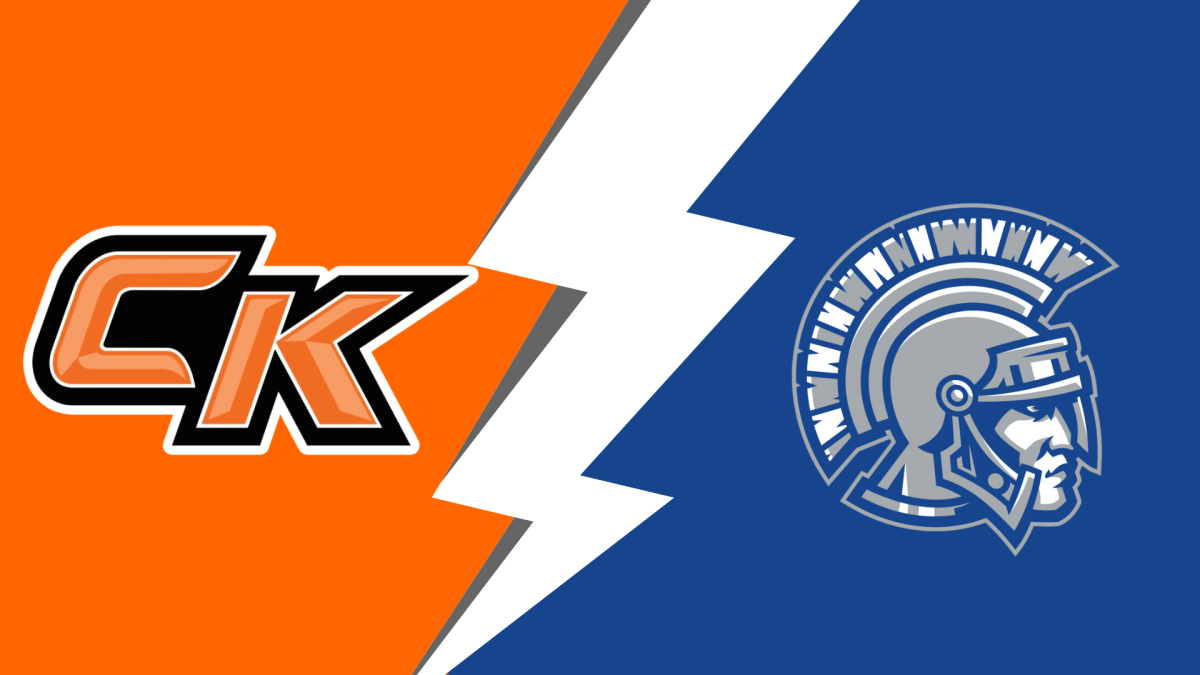The Effects of Social Media
Lauren Labow(Senior) and Ryley Petoff(senior) spend they’re lunch on their phones on a sunny day.
Social media, is one of the main influencers on the average teen in 2018. The average amount of time that a teen is spending on social media is about nine hours a day which consists of Instagram, Facebook and Twitter and other streaming websites, that is more than one third of the day wasted on social media. Teens who spent more time on social media had 2.2 times the risk of reporting eating and body image concerns says a study from the University of Pittsburgh . Another study from the same university showed that more time young adults spent on social media that they were most likely to have symptoms of sleeping disorders and depression. There are both pros and cons to social media, it isn’t all negative. Social media has positive effects like staying connected to loved ones across the country or just staying connected to friends in general.
A psychologist at Olympic High School, Faith Brown is an expert on the subject, she works with teens every single day therefore she sees the negative effects of social media. Brown has to deal with problems that consist of drama and student function at school.
”In my direct experience, the teams that I work with have had to navigate many incidents of drama occurring via social media and/or overuse of screen time that negatively impacts a student’s functioning at school.” Brown told the Cougar Chronicle.

The school has to put SnapChat codes to get students attention.
In the school systems and just with teens in general, it’s as if social media is taking over their lives and it almost influences everything they do. Even at Central Kitsap, in order to get people’s attention about upcoming events the school has to post on their social media page and put up signs telling people to follow the
snapchat account or twitter accounts for announcements.
The School having to resort to that speaks to how social media over usage is a problem.
Brown told the Cougar Chronicle her thoughts on the topic “I believe that youth, in particular, need to find a healthy balance in their lives when it comes to use of technology and social media. This generation of youth have never lived in a world where online social communication did not exist and much of their social realities happen via social media, making it difficult for them to have a clear boundary between their real and online worlds. It is the norm these days for youth (and others) to be zoned into their smart phones in an online social world disconnected from the real world. It’s hard to escape, yet a poor substitute for genuine connection with others and the universe and for necessary downtime. Overuse of social media can also limit social skills needed for the real world.”
Though one has to consider the negative effects of social media on teens, there are still plenty of positive effects of social media. Staying connected to the ones you love is a advantage of being plugged into social media.
Brown told the Cougar Chronicle the benefits of social media, “Social media is often a convenient avenue for youth to stay connected to family, friends, and an online community regardless of physical distance. In particular, youth who struggle with real-world social interactions often find it easier to feel connected and build relationships with others through social media. Social media can also be a forum for raising awareness and educating youth, with information able to reach a broad audience and allowing for critical thinking and open discussion.”

being appreciated on social media through “likes” was seen in a brain scan to activate the reward center of the brain.
With its massive influence on this generation the pros and cons balance out.
In recent interviews with students at Central Kitsap High School, there have been positive and negative views about social media. This generation is truly influenced by social media.
Social media does have its pros and cons according to multiple students but students mostly view social media in a positive light. In an interview with junior Erika Perry believes that our generation use of social media is beneficial but also tells that there is a negative beneficial side to social media. Perry states, “It’s beneficial in the sense that news spreads faster and people are more aware of what’s going on around them, but it’s not beneficial in the sense that many people start to think they have to act a certain way to go with society’s norms and try to fit in.”
Schools across the nation seem to experience the same effects of positives and negatives social media. Some more popular and pro reasons why social media is so beneficial is that you can connect with many people all over the world, learn about international news a lot easier, and be able to express your own ideas to the world.
In an article from June 28, 2016 on www.teenshiel.com, there are five points on why social media has a positive effect on teens. One of the arguments point out that social media can be used as a voice of reason for society. Kids and teenagers tend to use certain social media outlets such as Twitter, Facebook, and Instagram. On these outlets, “Facebook and Twitter are being used by the youth to create a voice for the voiceless.” An example explained on the website states that a group called “Disabled is not an inability” helps society be conscious on how to treat the disabled. Groups like these are created by the youth almost everyday to help treat everyone with respect and equality. Social media is the perfect place for the youth to help spread messages like this.
There are many cases why social media has a positive effect on society. In another interview with a student at Central Kitsap senior Emily McCann says, “positively it has connected me with a lot of people I have never talked to or met and keeps me connected with my friends, and it gives me a different view of the world”.
Students do agree that one of the most popular reasons why social media has a big impact on their life is that they connect with people from all across the globe.
Recently, seniors are trying to figure out who their future roommate for college is going to be. Using social media such as Twitter and Instagram helps them fulfill this situation. Students would use these media outlets and talk to potential future roommates and learn more and more about them. Seniors and these other individuals build a strong connection over social before next school year even starts.
Another great reason why social media has its positive effects on social media is that teens can gain knowledge on a whole greater scale than not being on the internet. Outlets again such as Twitter, Instagram, Facebook, and Youtube help kids and teenagers learn about what is going on in the world around them.
In the interview with junior Perry at Central Kitsap, she said, “Its beneficial in the sense that news spreads faster and people are more aware of what’s going on around them”.
Social media has had a lot of great positive impacts on kids and teens all across the world. From learning new information on the internet, making new friends through different social media outlets, and spreading positive views through other social networking sites; social media always has its pros.

Patricia Faletoi(senior) and Ready Lanki-Nimote on their phones during class.
Regardless of how teens feel there is scientific proof that social media has negative effect on teens. The side effects vary from anxiety and depression to sleep deprivation and cyber bullying and many emotional problems. To reduce the side effects of social media you should find a healthy balance and ‘unplug’ at least a hour before bed.
Brown told the Cougar Chronicle about the side effects of social media”Overuse of screen time can cause sleep and concentration problems and overuse of social media in particular, can result in teens ‘feeling less than’ as they compare themselves or their lives with what they see others displaying online. Lastly, cyber bullying can result in serious social and emotional problems and can have a life altering impact on victims.”
Social media is fun and all but it doesn’t need to take over your life; when you’re around friends put the phone down and spend quality time with them.We should all disconnect from the online world and connect to the real world as much as possible. We should find healthy replacements such as going on a walk, listening to music, or engaging in physical activity.


